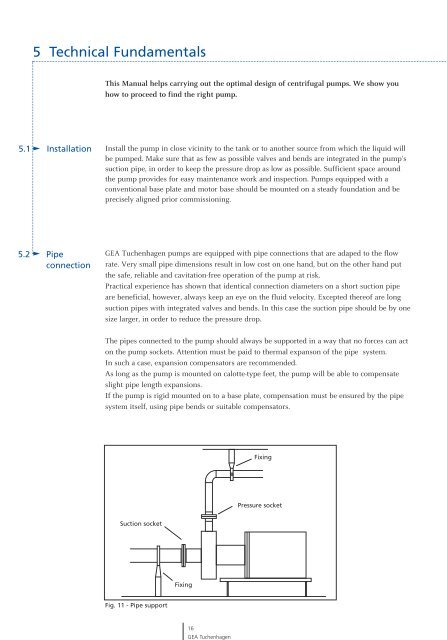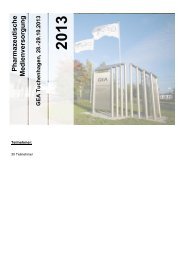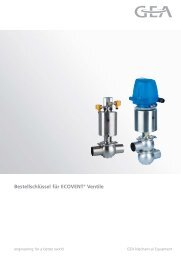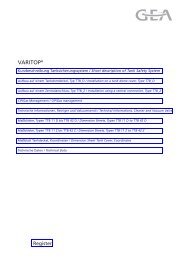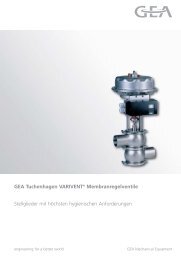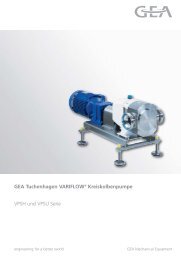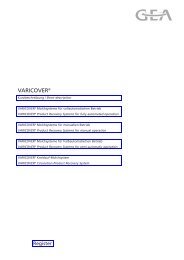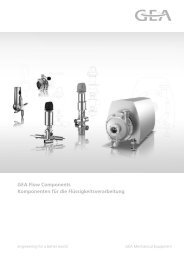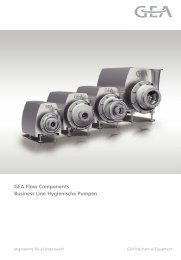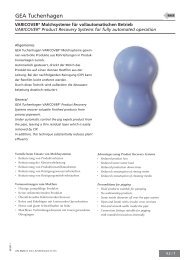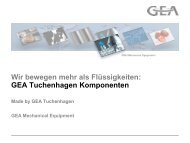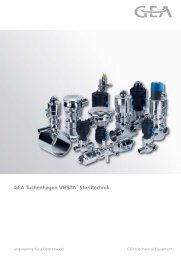Manual for the Design of Pipe Systems and Pumps - GEA ...
Manual for the Design of Pipe Systems and Pumps - GEA ...
Manual for the Design of Pipe Systems and Pumps - GEA ...
You also want an ePaper? Increase the reach of your titles
YUMPU automatically turns print PDFs into web optimized ePapers that Google loves.
5 Technical Fundamentals<br />
5.1 Installation<br />
5.2 <strong>Pipe</strong><br />
connection<br />
This <strong>Manual</strong> helps carrying out <strong>the</strong> optimal design <strong>of</strong> centrifugal pumps. We show you<br />
how to proceed to find <strong>the</strong> right pump.<br />
Install <strong>the</strong> pump in close vicinity to <strong>the</strong> tank or to ano<strong>the</strong>r source from which <strong>the</strong> liquid will<br />
be pumped. Make sure that as few as possible valves <strong>and</strong> bends are integrated in <strong>the</strong> pump‘s<br />
suction pipe, in order to keep <strong>the</strong> pressure drop as low as possible. Sufficient space around<br />
<strong>the</strong> pump provides <strong>for</strong> easy maintenance work <strong>and</strong> inspection. <strong>Pumps</strong> equipped with a<br />
conventional base plate <strong>and</strong> motor base should be mounted on a steady foundation <strong>and</strong> be<br />
precisely aligned prior commissioning.<br />
<strong>GEA</strong> Tuchenhagen pumps are equipped with pipe connections that are adaped to <strong>the</strong> flow<br />
rate. Very small pipe dimensions result in low cost on one h<strong>and</strong>, but on <strong>the</strong> o<strong>the</strong>r h<strong>and</strong> put<br />
<strong>the</strong> safe, reliable <strong>and</strong> cavitation-free operation <strong>of</strong> <strong>the</strong> pump at risk.<br />
Practical experience has shown that identical connection diameters on a short suction pipe<br />
are beneficial, however, always keep an eye on <strong>the</strong> fluid velocity. Excepted <strong>the</strong>re<strong>of</strong> are long<br />
suction pipes with integrated valves <strong>and</strong> bends. In this case <strong>the</strong> suction pipe should be by one<br />
size larger, in order to reduce <strong>the</strong> pressure drop.<br />
The pipes connected to <strong>the</strong> pump should always be supported in a way that no <strong>for</strong>ces can act<br />
on <strong>the</strong> pump sockets. Attention must be paid to <strong>the</strong>rmal expanson <strong>of</strong> <strong>the</strong> pipe system.<br />
In such a case, expansion compensators are recommended.<br />
As long as <strong>the</strong> pump is mounted on calotte-type feet, <strong>the</strong> pump will be able to compensate<br />
slight pipe length expansions.<br />
If <strong>the</strong> pump is rigid mounted on to a base plate, compensation must be ensured by <strong>the</strong> pipe<br />
system itself, using pipe bends or suitable compensators.<br />
Suction socket<br />
Fig. 11 - <strong>Pipe</strong> support<br />
Fixing<br />
16<br />
<strong>GEA</strong> Tuchenhagen<br />
Fixing<br />
Pressure socket


